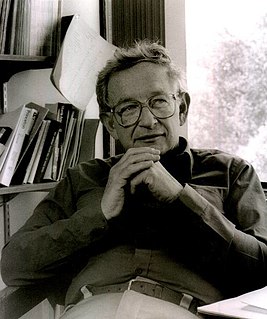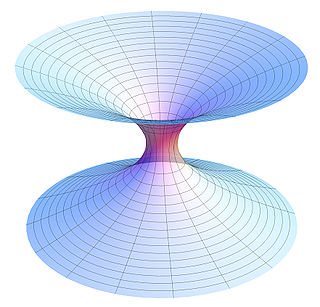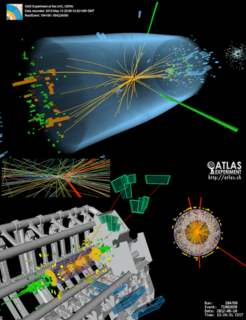
Symmetry in everyday language refers to a sense of harmonious and beautiful proportion and balance. In mathematics, "symmetry" has a more precise definition, and is usually used to refer to an object that is invariant under some transformations; including translation, reflection, rotation or scaling. Although these two meanings of "symmetry" can sometimes be told apart, they are intricately related, and hence are discussed together in this article.

In particle physics, supersymmetry (SUSY) is a conjectured relationship between two basic classes of elementary particles: bosons, which have an integer-valued spin, and fermions, which have a half-integer spin. A type of spacetime symmetry, supersymmetry is a possible candidate for undiscovered particle physics, and seen by some physicists as an elegant solution to many current problems in particle physics if confirmed correct, which could resolve various areas where current theories are believed to be incomplete. A supersymmetrical extension to the Standard Model could resolve major hierarchy problems within gauge theory, by guaranteeing that quadratic divergences of all orders will cancel out in perturbation theory.

In quantum field theory the vacuum expectation value of an operator is its average, expected value in the vacuum. The vacuum expectation value of an operator O is usually denoted by One of the most widely used examples of an observable physical effect that results from the vacuum expectation value of an operator is the Casimir effect.

Spontaneous symmetry breaking is a spontaneous process of symmetry breaking, by which a physical system in a symmetric state ends up in an asymmetric state. In particular, it can describe systems where the equations of motion or the Lagrangian obey symmetries, but the lowest-energy vacuum solutions do not exhibit that same symmetry. When the system goes to one of those vacuum solutions, the symmetry is broken for perturbations around that vacuum even though the entire Lagrangian retains that symmetry.

In quantum physics an anomaly or quantum anomaly is the failure of a symmetry of a theory's classical action to be a symmetry of any regularization of the full quantum theory. In classical physics, a classical anomaly is the failure of a symmetry to be restored in the limit in which the symmetry-breaking parameter goes to zero. Perhaps the first known anomaly was the dissipative anomaly in turbulence: time-reversibility remains broken at the limit of vanishing viscosity.

Philip Warren Anderson is an American theoretical physicist and Nobel laureate. Anderson has made contributions to the theories of localization, antiferromagnetism, symmetry breaking, and high-temperature superconductivity, and to the philosophy of science through his writings on emergent phenomena.

In particle physics, a gauge boson is a force carrier, a bosonic particle that carries any of the fundamental interactions of nature, commonly called forces. Elementary particles, whose interactions are described by a gauge theory, interact with each other by the exchange of gauge bosons—usually as virtual particles.
In nuclear physics and particle physics, isospin (I) is a quantum number related to the strong interaction. More specifically, isospin symmetry is a subset of the flavour symmetry seen more broadly in the interactions of baryons and mesons.

Yoichiro Nambu was a Japanese-American physicist and professor at the University of Chicago. Known for his contributions to the field of theoretical physics, he was awarded half of the Nobel Prize in Physics in 2008 for the discovery in 1960 of the mechanism of spontaneous broken symmetry in subatomic physics, related at first to the strong interaction's chiral symmetry and later to the electroweak interaction and Higgs mechanism. The other half was split equally between Makoto Kobayashi and Toshihide Maskawa "for the discovery of the origin of the broken symmetry which predicts the existence of at least three families of quarks in nature."

In physics, symmetry breaking is a phenomenon in which (infinitesimally) small fluctuations acting on a system crossing a critical point decide the system's fate, by determining which branch of a bifurcation is taken. To an outside observer unaware of the fluctuations, the choice will appear arbitrary. This process is called symmetry "breaking", because such transitions usually bring the system from a symmetric but disorderly state into one or more definite states. Symmetry breaking is thought to play a major role in pattern formation.

The Fabric of the Cosmos: Space, Time, and the Texture of Reality (2004) is the second book on theoretical physics, cosmology, and string theory written by Brian Greene, professor and co-director of Columbia's Institute for Strings, Cosmology, and Astroparticle Physics (ISCAP).
In particle physics, flavour or flavor refers to the species of an elementary particle. The Standard Model counts six flavours of quarks and six flavours of leptons. They are conventionally parameterized with flavour quantum numbers that are assigned to all subatomic particles. They can also be described by some of the family symmetries proposed for the quark-lepton generations.
In theoretical physics, explicit symmetry breaking is the breaking of a symmetry of a theory by terms in its defining equations of motion that do not respect the symmetry. Usually this term is used in situations where these symmetry-breaking terms are small, so that the symmetry is approximately respected by the theory. An example is the spectral line splitting in the Zeeman effect, due to a magnetic interaction perturbation in the Hamiltonian of the atoms involved.

In physics, a symmetry of a physical system is a physical or mathematical feature of the system that is preserved or remains unchanged under some transformation.

In mathematics and physics, the term generator or generating set may refer to any of a number of related concepts. The underlying concept in each case is that of a smaller set of objects, together with a set of operations that can be applied to it, that result in the creation of a larger collection of objects, called the generated set. The larger set is then said to be generated by the smaller set. It is commonly the case that the generating set has a simpler set of properties than the generated set, thus making it easier to discuss and examine. It is usually the case that properties of the generating set are in some way preserved by the act of generation; likewise, the properties of the generated set are often reflected in the generating set.
The J. J. Sakurai Prize for Theoretical Particle Physics, is presented by the American Physical Society at its annual April Meeting, and honors outstanding achievement in particle physics theory. The prize, considered one of the most prestigious in physics, consists of a monetary award, a certificate citing the contributions recognized by the award, and a travel allowance for the recipient to attend the presentation. The award is endowed by the family and friends of particle physicist J. J. Sakurai. The prize has been awarded annually since 1985.

Theoretical physics is a branch of physics that employs mathematical models and abstractions of physical objects and systems to rationalize, explain and predict natural phenomena. This is in contrast to experimental physics, which uses experimental tools to probe these phenomena.

The Higgs boson is an elementary particle in the Standard Model of particle physics, produced by the quantum excitation of the Higgs field, one of the fields in particle physics theory. It is named after physicist Peter Higgs, who in 1964, along with five other scientists, proposed the Higgs mechanism to explain why particles have mass. This mechanism implies the existence of the Higgs boson. The boson's existence was confirmed in 2012 by the ATLAS and CMS collaborations based on collisions in the LHC at CERN.

Superfluid vacuum theory (SVT), sometimes known as the BEC vacuum theory, is an approach in theoretical physics and quantum mechanics where the fundamental physical vacuum is viewed as superfluid or as a Bose–Einstein condensate (BEC).

Time translation symmetry or temporal translation symmetry (TTS) is a mathematical transformation in physics that moves the times of events through a common interval. Time translation symmetry is the hypothesis that the laws of physics are unchanged, under such a transformation. Time translation symmetry is a rigorous way to formulate the idea that the laws of physics are the same throughout history. Time translation symmetry is closely connected, via the Noether theorem, to conservation of energy. In mathematics, the set of all time translations on a given system form a Lie group.












